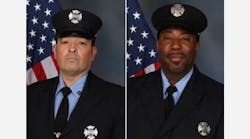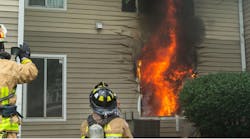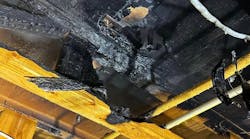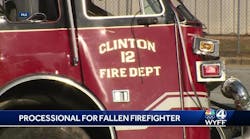This article explores when to flow water and when not to flow water. Since there are various types of conditions you will encounter, here are some "heads up" techniques. For example, while pushing your line into a fully involved building, obviously you will be flowing water the entire time. However, most fires are a little trickier than that.
When you enter a smoke filled building it's important to know the environment around you, how hot it is. One thing that needs to be understood by firefighters is that our gear is better than it's ever been in the history of firefighting, and allows us to get into very hot environments, sometimes without the wearer knowing how hot it actually is around him. Each firefighter needs to develop his or her own techniques to be aware of how hot the environment is. It is important to know how hot your environment is for many safety reasons, one being that the smoke that fills the envelope or room that you are in is also flammable. Smoke consists of carbon, which will ignite at about 1200 degrees. However, most building fires do not have enough oxygen for that carbon to ignite.
One technique I developed was, after knocking one room of fire down, to take the hose line and open it up directly above me in a straight stream and let the water rain back down on my gear. My technique ensured that if the water came back down and hit me on the shoulders and was steaming hot, I knew that I was in an incredibly hot environment. If the water comes back down steaming hot, you either have one of two things going on. You either have fire in the partitions or in the room ahead of you which is still continuing to generate heat, indicating that you need to proceed cautiously to prevent becoming caught in a flashover type event. However, if the water came back down and wasn't hot, then I knew that the fire was probably knocked down, and that I could proceed forward a little more rapidly.
Another trick that we used back in the day was to go ahead and use a straight or solid stream to sweep a path. When a room burns, it's going to leave a layer of three or four inches of hot embers and coals on the floor, similar to the bottom of a charcoal barbeque grill on the back deck when you are cooking hot dogs and steaks. By using that water to sweep the hot embers out of the way, you don't have to crawl through them. This also gets rid of glass, hypodermic needles and other objects that you definitely do not want to be crawling through. This technique makes it a lot easier to advance your hose line, and prevents the newer plastic hoses from being burned through. The traditional double jacket polyester hoses are more resistant to burning through, but will do so if they are allowed to sit in the hot coals and embers for a long enough period of time. While sweeping the floor, listen to the sound the water makes as it hits the floor. Any change in noise or loss in sound might indicate that the floor has been burned out. Be extra cautious around openings such as stairwells and elevator shafts. After sweeping your path, it is a good opportunity to shut your line down for a second and get everybody quiet and just listen. Listen for popping, crackling, the water dropping down, steam, and feel the steam start to lift off of you a bit. Hopefully, your support services we call "truckies" will open it up for you and conditions should start to improve rapidly. Once again, as all this is happening, and you hear the truck guys breaking windows and doing their thing and if conditions are not improving, it's time to start opening walls or considering the possibility that you have more rooms in front of you still on fire. You definitely want all the fire in front of you; never let it get behind you if at all possible.
Engine Officers
I have been working many years in urban environments with some excellent guys, and I've worked with some guys who probably should have been serving hamburgers at McDonald's. A good engine officer will always be right next to his nozzle person. Keep in mind, when you are on the pipe, you will tend to get tunnel vision, and that's not a bad thing. I hear instructors talk about tunnel vision as if it's something to be ashamed of, but a good nozzle person will naturally develop tunnel vision because he is after one thing; knocking that fire down. So the engine officer being beside you affords the opportunity for him to take in the big picture. It also is psychologically reassuring to have someone with you, to encourage you when you are just about out of courage, put a hand on your shoulder and say, "Come on, let's go, move forward." So many engine officers want to assume command, stand in the front yard, bark orders and yell, and often they are just covering their own cowardice, they didn't want to go in that building in any way, shape, or form. We all loathed them; we despised them for this attitude. A good officer will never send his or her people any place that he or she wouldn't go themselves.
That's all for this article, in a future article we will explore the psychological aspects of the pipe.





